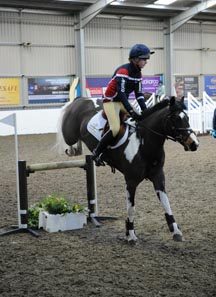Do you want to read more about training tips?
View the gallery of Caroline Moore’s winter training feature.
With two months to go before the eventing season really kicks off, now’s the time to practise the questions that will arise with the help from BE coach Caroline Moore.
Developing the canter
It’s vital to develop a feel for jumping out of the three different canters that you use cross-country.
For the experienced rider, this will come naturally. However, for the less-experienced rider, it needs to be practised, along with the “gear changes” that are regularly required on today’s courses.
The gears
1st gear… trot. Occasionally used for the leafpit type of fence, ditches, steps and water with young horses.
2nd gear…. coffin canter. A short-stepping, high-powered canter often used for fences where there is a suprise for the horse on landing, such as a ditch or water, and the horse may need an extra stride to read the question. This canter needs to be taught and practised – you will often see a rider just use the hand without the leg and kill the canter’s power. This results in the horse’s head going up too high, which takes away his line of sight and a poor jump.
3rd gear…. showjump-type canter. More step than the coffin canter. Needed for vertical rails or fences that are related to each other with a distance. The importance of this canter is that it is forward, well balanced and the rider has a soft hand.
4th gear…. the gallop. This is the speed that most cross-country fences are jumped out of, including brushtops, rolltops, spreads, tables and so on. This pace is NOT top speed, but should be balanced with power and the hocks put more underneath four or five strides out.
5th gear…. top speed. Not generally jumped out of.
Once I have worked with a rider to develop the different canters and gallop, I use three different types of fences: an upright set of rails (to get the rider to imagine a ditch downhill on the landing), a double of skinnies and a triple bar in a big area such as a field, large surface (in the winter) or on the gallops.
I’ll set the horse and rider off generating a good fourth gear and practise over the triple bar, using their eye to read the stride pattern as far out as possible.
Then I get them to practise moving from fourth to third to second gear using all three fences.
This exercise trains the rider to find out how far away from the fence the horse needs balancing. It helps develop a good partnership and enables the rider’s eye to develop.
This is also a great time to practise the gallop seat and develop a secure lower leg.
About Caroline Moore
Caroline is a Fellow of the British Horse Society and a British Eventing accredited coach. She has ridden up to four-star level and has recently been appointed as the junior team coach and national under-18 coach.
“As a coach, I want the exercises to be fun for the horse and the rider, as well as challenging and educational,” she says. “It’s really important to raise the boundaries in training without the partnership losing their confidence.”
For more information, visit www.caroline-moore.com.
To read the full feature on early-season schooling see the current issue of H&H (2 February 2012)
View the gallery of Caroline Moore’s winter training
Read all the latest eventing news



